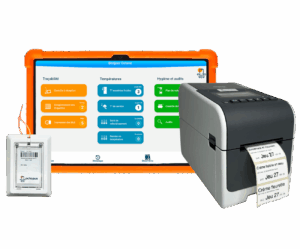Octopus HACCP paperless food traceability
This article explains what product traceability consists of and what a traceability label is. We will also review the information to be retained within the framework of HACCP traceability for your foodstuffs and the available means to ensure optimal tracking.
Guarantee all traceability steps with Octopus HACCP.
Definition of food product traceability
Food traceability, which is part of the 7 principles of HACCP, allows to faithfully trace the journey of a food item from its production to its distribution to professionals or end customers, including the transformation stages. This regulatory procedure involves 3 distinct phases in the documentary tracking of the product’s lifecycle:
Upstream traceability
Step 1 of food product traceability consists of identifying the supplier, the nature and quantity of food products delivered (raw materials), the batch number, the expiration date (DLC), and specifying the delivery date. This stock intake phase is accompanied by additional checks, including temperature readings of fresh and frozen products and verification of product integrity.
For upstream traceability, you must keep annotated delivery notes and traceability labels for each food product (designation, batch number, DLC, etc.).
Internal traceability
Step 2 of food product traceability must allow linking the raw materials received to the finished products. To ensure this internal traceability, raw materials and ingredients used in preparations must be identified. This step results in the issuance of a traceability label for each opened, unpacked, transformed, or prepared product, which must at least include the manufacturing or opening date and the secondary DLC.
As a reminder, the calculation of secondary DLCs by type of food must comply with the manufacturer’s storage durations or have undergone microbiological study.
For internal traceability, you must strictly keep traceability labels of the raw materials used, unpacked products, and processed products.
Downstream traceability
This stage of the food traceability process takes place when you distribute your packaged products to professionals. It allows you to identify your customers and the delivered products. As with the previous traceability stages, you must keep delivery notes including batch numbers and secondary DLCs.
Objectives of food traceability
HACCP traceability is a demanding process aiming to guarantee the food safety of consumers and ensure your compliance with HACCP regulations. It requires time-consuming procedures that mobilize resources and space to store traceability labels and other documents related to stored food products.
Regulations specify that traceability labels must be kept:
- 6 months for perishable products with an expiration date less than 3 months;
- 5 years for other products.
The traceability register thus created must enable you, in case of sanitary inspection, to present all supporting documents, or if a case of foodborne illness outbreak (TIAC) occurs, to quickly identify the implicated foods and batch numbers in order to take appropriate measures in compliance with your PMS.
How to ensure food traceability
Regulations do not impose a specific means to ensure food product traceability. Generally, recording information in the different HACCP traceability phases is done manually by cutting out product labels, annotating them, and storing them in binders or archive boxes. Secondary DLCs on unpacked products and filling in labels for processed products are also done manually. Manual entry, cutting, storage, and archiving of traceability labels are labor-intensive activities prone to errors.
The use of the software Octopus HACCP secures these food traceability procedures by offering optimal control of critical points. The HACCP application, compatible with mobile and tablet devices, simplifies information recording upon receipt control, with pre-filled supplier identification, automatic delivery date, and easily accessible fields for entering times and batch numbers. Label recording is done with a single click using the camera of your mobile or tablet, and archiving is also automatic. Similarly, label printing is integrated into the Octopus HACCP solution, with automatic calculation of secondary DLCs by product type.
Using the Octopus HACCP application significantly reduces the volume of paper documents to manage. It facilitates monitoring of critical points related to food safety and the implementation of corrective actions. In case of inspection, all information is available and easily accessible.
Want to learn more about the topic? Check our article to better understand the HACCP method.
FAQ
How to ensure product traceability?
To ensure food traceability of a product, a strict procedure must be implemented for control and identification of products upstream during the receipt of goods, internally during the processing phase, and downstream during the distribution phase. Each step involves verifying the sanitary compliance of the products and collecting traceability labels that will be archived and kept as supporting documents in case of inspection or foodborne illness outbreak (TIAC).
What is food traceability?
Food traceability is a procedure for monitoring critical control points (CCPs). It is the means to trace the journey of a food item from production to the consumer’s plate, ensuring its food safety.



